Laboratory of quantum measurements
Our most advanced laboratory is equipped with a dilution He3-He4 refrigerator from Leiden Cryogenics with base temperature as low as 11 mK and cooling power of 1.2 mW @ 100 mK. Measurements tracts are installed with state-of-the-art cryogenic amplifiers, allowing to carry out sensitive measurements on superconducting electronic circuits even in quantum regime, in the architecture of circuit quantum electrodynamics (cQED). For these experiments, the laboratory is equipped with RF and precision DC electronics, such as vector network analyzer, power spectrum analyzer, RF generator, arbitrary waveform generators, pattern generator, which enables the carrying out of various spectroscopic experiments (up to ~ 50GHz) and precision transport measurements. The laboratory is located at QUTE at Slovak Academy of Sciences.
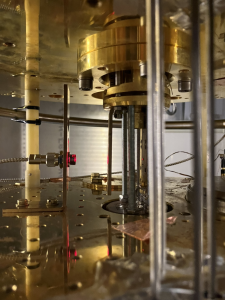
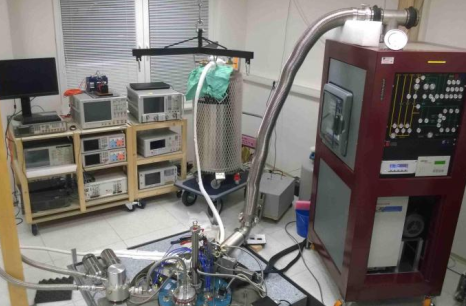
Laboratory of electromagnetic measurements
This laboratory focuses on the DC and RF characterization of superconducting thin films, micro and nano-structures and superconducting electronics, as well as nano-magnetism. The laboratory is equipped with RF and precision DC electronics, such as vector network analyzer, power spectrum analyzer, rf generator, arbitrary waveform generators, pattern generator, which enables the carrying out of various spectroscopic experiments (up to ~20GHz) and precision transport measurements.
Experiments on superconductors are carried out in an Oxford Instruments 3He refrigerator with base temperature of 300mK with RF and DC measurement tracts. The simple operation and short cooldown cycle, makes it suitable for fast characterization of samples and convenient introduction to cryo-physics for students.
For magnetic measurements, the laboratory is equipped with a dipole electromagnet (peak field of 1.5T), mounted with a measurement tract that enables us to carry out measurements involving ferromagnetic resonance (FMR) ultra-thin ferromagnetic layers and nano-structures, electron paramagnetic resonance (EPR), the Hall effect, and the DC characterization of various magnetic materials and structures.
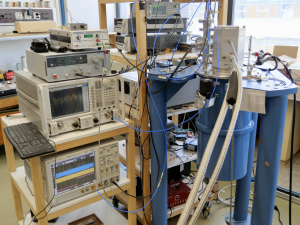
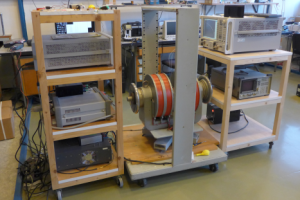
Laboratory of sample processing
This laboratory consists of a cleanroom separated into two sections and an antechamber. All three rooms are held at positive pressure to reduce dust accumulation and held at 18-26 degrees Celsius.
Section A – Class 5 (according to ISO 14644-1) space designated for the production of ultra-thin superconducting films by means of magnetron sputtering.
This room is equipped with a vacuum chamber capable of achieving pressures up to 5E-6 mbars through a tandem of turbomolecular and membrane pump, set with instrumentation (pressure and temperature gauges), electronic gas flow control at inlets and a magnetron with an electromechanically actuated shutter, allowing to carry out reactive magnetron deposition with high repeatability. Currently, Molybdenum Carbide (MoC) thin films with world-class parameters are being produced here.
Further equipment includes a vacuum storage chamber, spin coater, ultrasound basin and a Van der Pauw measurement rig, making the laboratory self-sufficient in treating wafers, characterizing produced layers and storing them for extended time periods.
Section B – Class 4 space designated to host a lithography system and an ion etching chamber in the near future, allowing us to pattern resonators in-house.
Laboratory of Thin Film Deposition
This room is equipped with a vacuum chamber capable of achieving pressures up to 5E-6 mbars through a tandem of turbomolecular and membrane pump, set with instrumentation (pressure and temperature gauges), electronic gas flow control at inlets and a magnetron with an electromechanically actuated shutter, allowing to carry out reactive magnetron deposition with high repeatability. Currently, Molybdenum Carbide (MoC) thin films with world-class parameters are being produced here.
Further equipment includes a vacuum storage chamber, spin coater, ultrasound basin and a Van der Pauw measurement rig, making the laboratory self-sufficient in treating wafers, characterizing produced layers and storing them for extended time periods.
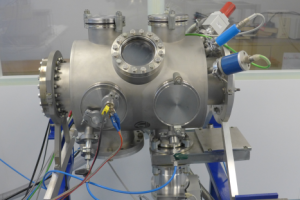
Laboratory of computer-aided manufacture
This laboratory focuses on using a variety of CAM processes to produce parts and components to custom specification.
Equipment includes:
- a PROTOMAT E33 rapid prototyping PCB mill, capable of producing custom printed circuit boards with a detail level of 0.25mm (up to 0.1mm with special-purpose milling bits). Its ability to drill as well as to remove surface material greatly simplifies the production of printed circuit boards.
- a CNC mill that allows for the machining of small parts with features difficult to achieve otherwise, using direct g-code input. Tungsten carbide milling bits (collet takes tools with stem 1-3.2mm) allow for the efficient processing of a variety of materials, including steel.
- a Prusa MK3 3D printer capable of producing custom parts from a variety of plastics, including but not limited to nylon, ABS, PETG and PLA with a detail level of 0.15mm.
- a converted DLP projector capable of illuminating photosensitive boards to efficiently produce larger printed circuit boards patterned using digital imagery without the need for a physical mask.